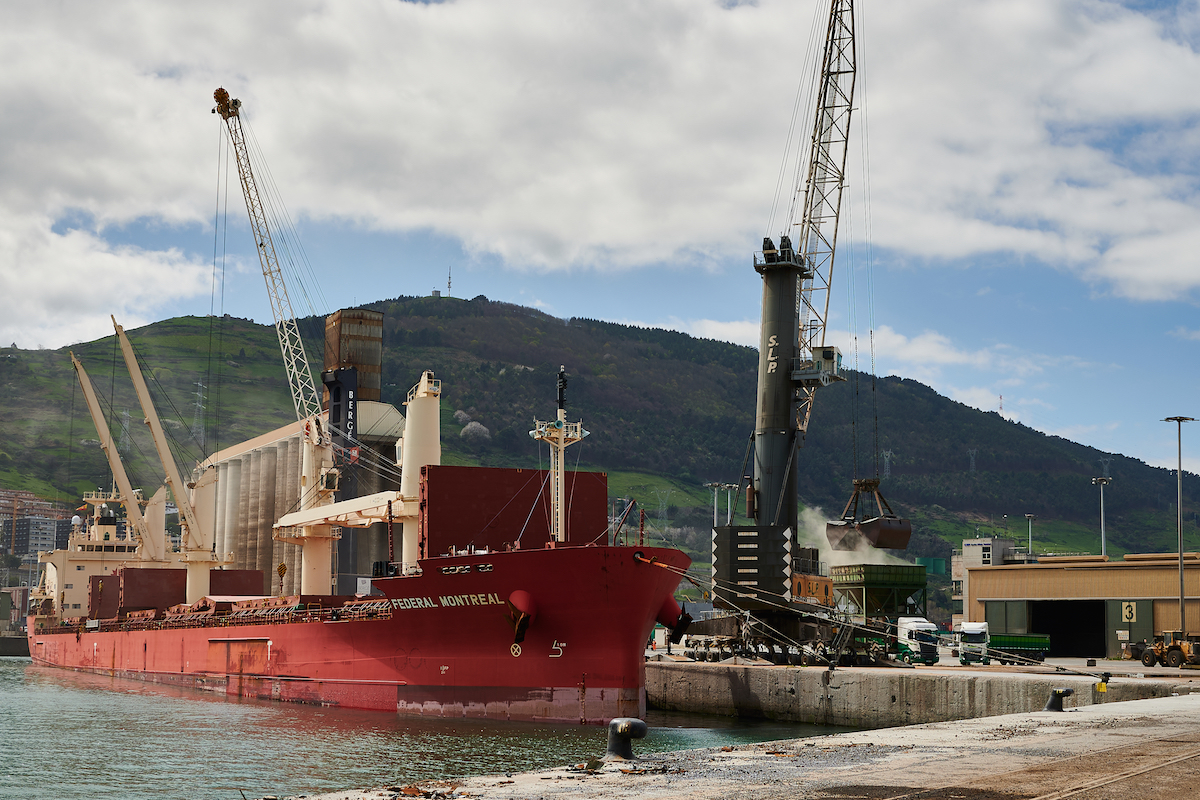End-of-year traffic figures for 2023 for the port of Bilbao totalled 32.8 million tonnes, up 0.11% on 2022 figures and attributable mainly to bulk liquids and solids.
This increase has been hindered by an exceptionally complicated month of December due to bad weather, which has caused delays in the arrival of vessels. Specifically, more than half a million tonnes and 21 port calls were lost during the month. On 1 and 2 January alone, thirteen vessels entered the port that were due to have berthed in December. If it weren’t for these delays, the end-of-year figure would have been 1.7%.
Despite this setback, the port of Bilbao has benefited from its multi-purpose nature, from its specialisation in handling all types of goods regardless of their nature, volume, weight or complexity. As a result, figures for total traffic are 3.3% higher than the average for State Ports, with results down in eight of the twelve main ports. Likewise, figures for container traffic (0.9% down on the previous year) are better than the average for the ports of the Spanish port system (5.5% down on the previous year).
It is important to note that the port of Bilbao, unlike other major ports, is not a port of transit. Bilbao ranks third in exports with 8.3 million tonnes, behind only Valencia and Barcelona, and ahead of Cartagena and Algeciras. It is also third in terms of imports with 21.3 million, behind Cartagena and Tarragona, and ahead of Barcelona and Valencia. These figures confirm its importance for the economy of its hinterland, and its strength as a logistical-industrial port. In this sense, 38% of the port surface area under concession is used by industrial companies, which manufacture or transform materials dockside into end products, mainly in the energy and wind energy sectors.
In addition to being a port with the capacity and experience to handle all types of traffic, where transport, services, logistics and industry go hand in hand, the Port Authority’s commercial policy, also at the service of its hinterland, gives priority to traffic of high strategic value, even if it adds up to fewer tonnes, such as project cargoes, among which wind power components feature prominently. In 2023, 3,600 special transport consignments entered the port, an average of ten a day.
Increase in bulk cargo
In terms of cargo type, figures for bulk liquids, despite the fall in production at the Petronor refinery due to its temporary technical shutdown, are up 1%. Bulk solids are up 4.4%, with petroleum coke exports and imports of cereals and their flours of particular relevance.
Figures for general cargo fell by almost 4%. Within conventional cargo, figures for machinery and construction materials are up, whilst the best performing containerised goods are also construction materials. Despite a 3% fall overall, these figures also outperform the average for the state port system, which fell by almost 5%.
In absolute terms, the best performing cargo types were diesel oil, cereals, construction materials, biofuels, soya beans and animal feed and fodder. On the other hand, stand-out negative figures were recorded for crude oil, fuel oil, chemical products, beverages, cement and clinker, and paper and pulp.
Market leaders with the UK and Ireland
The main markets in terms of overall traffic, including liquids, are the United States (12% of traffic), Brazil (9%), Russia (8%), the United Kingdom (7%) and Mexico (6%). The countries showing the greatest

growth are Norway (imports of oil and gas), Brazil (imports of oil), Nigeria (imports of gas), Belgium (exports of oil and mineral products), India (imports of diesel and steel products) and Mexico (imports of oil and exports of steel products). The Port of Bilbao continues to lead the market in terms of traffic with the United Kingdom and Ireland, and 33% of Spanish traffic passes through the port.
More vessels and passengers
Vessel movements closed at 2,738 calls, an increase of 96 vessels (+3.6%). Vessel size (GTs) is up 9% due to the increase in the number of container ships, cruise ships and the new and more sustainable roll-on/roll-off vessels of Finnlines and Brittany Ferries.
Passenger numbers are up 26.5% to 270,771. The number of regular line passengers (ferries with the United Kingdom and Ireland) is up 16%, i.e. 17,059 more passengers than in 2022, while figures for cruise passenger traffic, with 80 cruise ship calls, stand at a total of 149,032 (+36%) tourists, a record for the port.
29% of containers transported by rail
In 2023, 4,238 trains operated in the port of Bilbao, a figure similar to that of 2022, representing an average of almost 12 trains per day. The share of containers entering or leaving by rail has once again increased from 27% to 29%, consolidating the position of the port of Bilbao as the leader in the port system. This growth and the commitment to rail is in line with one of the EU’s key objectives to promote decarbonisation.
In this respect, and with a view to improving rail operations, the Port Authority has been managing rail traffic and manoeuvres in the port area since 2022, and has signed another agreement with Adif in 2023 for the container terminal that the Spanish state-owned company still manages. Specifically, a contract has been signed for the Port Authority to manage operations related to cargo handling, access control and telephone and telematic services for operators, thus reinforcing the collaboration between the two administrations and continuing the strategy of further improving service provision in the port.
The Port Authority is also taking active part in the initiatives of the Basque Government and the Chambers of Commerce to combine efforts to progress with the Atlantic Corridor project. Similarly, the project for the southern goods rail bypass is expected to be taken forward in the near future.

 Port access
Port access